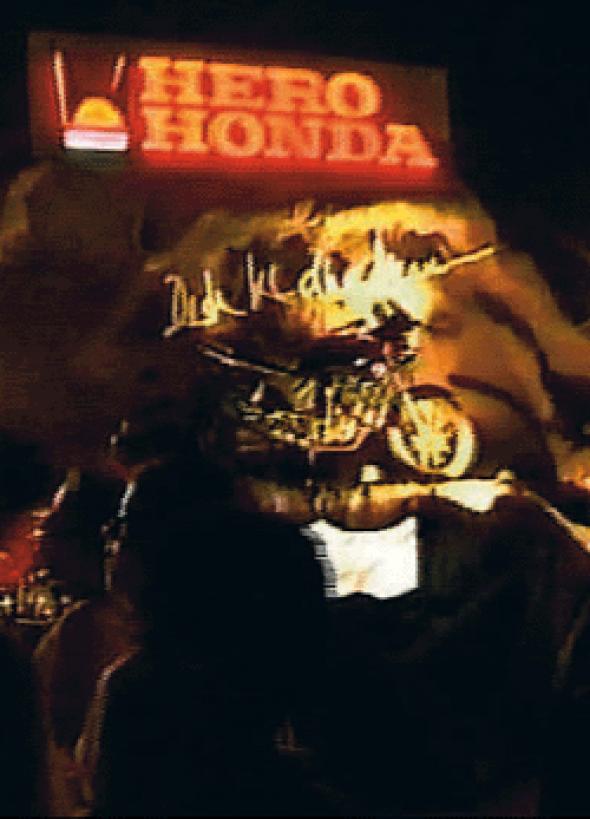War and Peace
It was three years in the making, and completed before September 11 made its indelible mark, but Anand Patwardhan’s remarkable film War and Peace grows in relevance the longer the ‘War on Terror’ goes on. Pauline van Mourik Broekman on a passionate and pacifist anatomy of South Asian nuclear politics
At the end of last year, London’s Institute of Contemporary Art screened Anand Patwardhan’s War and Peace, a film whose epic scope and methodical denunciation of Indian and Pakistani ‘nuclear nationalism’ have won it plaudits worldwide. Four months later, the legal battle which ensued between Patwardhan and India’s Central Board of Film Classification (CBFC) after the latter banned the film and called for 21 dubious and politically motivated cuts before it could be exhibited, has finally come to an end. Bombay’s High Court found that the CBFC’s demands contravened constitutional principles of free speech and posed a threat to society by suppressing alternative, internally consistent, views of reality. The court’s ruling gives War and Peace its rightful chance of being screened in the form its director intended and, more importantly, of being seen by inhabitants of the country whose tumultuous relationship with pacifism it explores.
War and Peace is bookended and interleaved by elegiac tributes to the non-violent resistance of Mahatma Gandhi, a figure to whom the film’s connection is made more direct by acknowledging the legacy of Patwardhan’s uncles’ involvement in the Gandhian freedom movement. A cinematic recitation of Gandhi’s ‘law of love’ constitutes the spine of the film, a political argument articulated through documentary sections on the Pakistan-India Forum For Democracy’s cross-border meetings, day-to-day life at the Vedcchi ashram (still the residence of Narayan Desai, son of Gandhi’s secretary), and the Global Peace march commemorating the 30th anniversary of India’s first overground nuclear test.
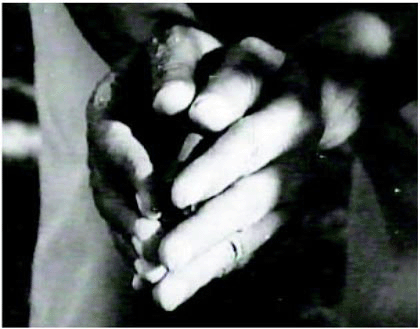
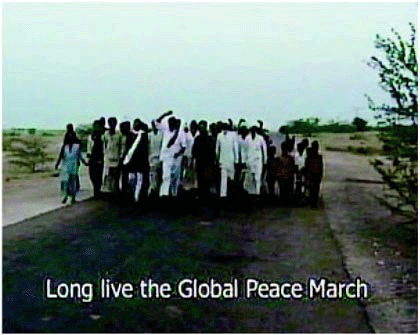
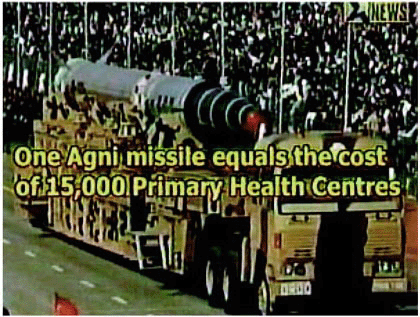
Patwardhan’s film has primarily been viewed as an indictment of India and Pakistan’s violent logic of nuclear escalation. And rightly: the film leaves no stone unturned in its efforts to demonstrate how India’s ruling elite – here, a pragmatic alliance of Hindu BJP government politicians, self-serving scientists, and religious leaders – has come to successfully construct the nuclear bomb as the sine qua non of proud nationhood. Nuclear capability is an access all areas card for the grown up game of global politics, and it places India fairly and squarely next to the United States, its eternal flame. Each of the film’s set pieces bring closer into view the catalytic process by which the state celebrates and consolidates its love affair with the bomb. Most memorable are the sequences showing ceremonial tributes in which scientists are venerated like modern gods. Such vignettes, intercut with repeated declarations of peaceful intent from actual Indian citizens and other footage evidencing an apparently unanimous desire for the continuation of everyday life, argue that the real battle is not between Pakistan and India, or South Asia and sundry emergent nuclear superpowers, but between the elite and the population that grants them their mandate. Scene after scene reveals the role a certain scientistic mysticism plays in this process, providing a semiotic vessel for the compelling brew of hurt pride, economic ambition, political jealousy and human fear that the elite deploy to gain the leverage they need over their subjects. In this new cosmology, nuclear weapons guarantee both peace and supremacy and create no ill effects, harming either no civilians at all or only the ‘right’ ones. The result is a profoundly contradictory doublespeak in which self and other, speaker and listener, become equally deluded. The impression of accumulating mendacity the film gives is quite overwhelming.
Where War and Peace really hits home though is in its argument against rigidly localised interpretations of this collective hoax. This in turn informs its commitment to a potentially transnational opposition movement. Religious cultures such as India’s – all too often cast as untypically ‘irrational’ – are revealed in this film to be ubiquitous and by no means a thing of the past. Unaccountable rule, with no transparency and an opportunistic disregard for civilian lives are shown to be equally universal and contemporary phenomena. If their contours are more recognisable in some instances than others, than this merely serves to illustrate the contingency of their cultural expression. The film does this, initially, by exploring the discursive patterns that characterise both India and Pakistan’s response to the situation in Kashmir. The Kargil War continues to claim lives but military sacrifice is valorised in cultural artefacts like Hero Honda’s 50-Day War Musical featuring the Tiger Hill attack of May, 1999 in which Indian soldiers established command over this ‘strategic’ mound. Later in the film, a Pakistani currency exchange office provides the director with a potent ‘found object’: a map of the globe whose green Islamic component increases exponentially between the 20th and 21st centuries to end up blocking out all other colours. Back in India, this totalitarian impulse then finds itself vocalised in a sequence where Hindu nationalists claim that Nostradamus predicted the entire world would one day be Hindu.
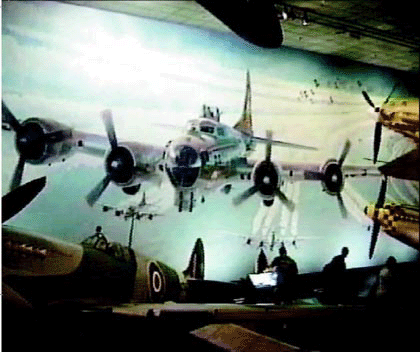
In the second part of the film, ‘The Legacy’, state culture’s structural denial of nuclear realities is explored in extended sections on the Second World War. Particularly telling is Patwardhan’s exploration of the US government’s suppression of a recent exhibition at Washington’s Smithsonian National Air and Space Museum which tried to analyse the historical context of the US bombing of Hiroshima and Nagasaki. This project, which became possible when government documents were declassified, would have presented Truman’s cognisance of Japan’s intention to surrender (an exchange of letters illustrates the fact), alongside documentation of the horrific deaths suffered by Japanese civilians. Put together in part by the historian Kai Bird, his ominous account of the ‘McCarthyite’ witchhunt of the exhibition’s curators which followed foreshadows the absolutist modus operandi of the Bush administration post-September 11.
War and Peace’s montage draws further parallels between Indian and US nuclear ‘rites’. Albeit mysteriously short and unaccompanied by visual contextualisation, footage of a Christian celebration at an American church is deployed to mirror the Indian religious context: a flamboyantly dressed preacher expounds the virtues of peace in a feverishly nationalistic speech – followed by shots of the Indian Prime Minister, Vajpayee, doing much the same.
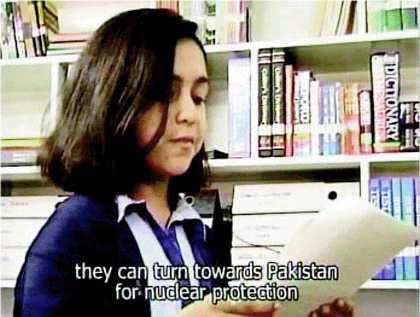
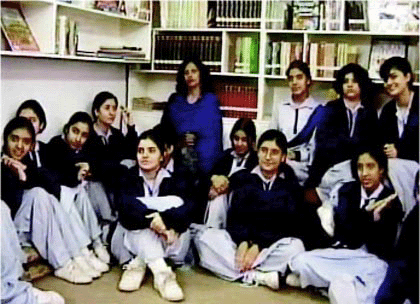
But religious fervour is, perhaps, War and Peace’s straw man. Whipping up a pious politics of peace-through-aggression only does half the job in notionally secular democracies. In one of the film’s most hilariously brilliant illustrations of the dynamics of nuclear persuasion, we instead witness the epitome of rational argument: a debate. Held in a Pakistani girls’ school, the sequence shows the pupils, eager to hone their rhetorical skills, excitedly playing to win. After delivering withering attacks on India, arguing for preventative nuclear supremacy, and essentially recycling their elders’ tricks wholesale, one of the girls is asked to state the cause of her wrath and the reasons for her zeal. It takes only a split second for the doubt-inflected query to make her crumble. The pupil admits that her views were calculated to conform to popular sentiment and to bolster her chances of winning the debate. A humble apology follows. The sequence may function as a parable, rather than a realistic model for future political discourse, but it sure makes you wish her elders would show some of the same grace.
Anand Patwardhan: [http://www.patwardhan.com]
Pauline van Mourik Broekman <pauline AT metamute.com> is the co-editor of Mute. ‘The Vanishing: The Art of Making Things Disappear’, her essay on artistic responses to nuclear technology, appears in Locus Solus: site, identity, technology in contemporary art, Black Dog/Locus+, 2000
Mute Books Orders
For Mute Books distribution contact Anagram Books
contact@anagrambooks.com
For online purchases visit anagrambooks.com


